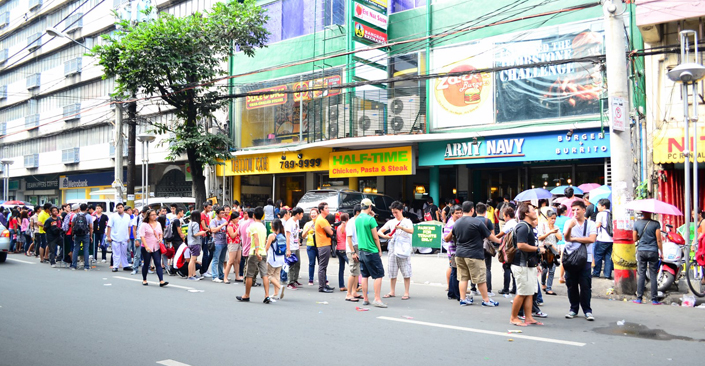“Saan tayo kakain (where will we eat),” is a question frequently heard among students. With only three canteens operating in the school, each with limited selection and seating capacity, students often look to the surrounding establishments for food. Many of which are fast food chains.
Along and around Taft Avenue, dozens of restaurants and fast food chains have opened every so often. Most recently, a fastfood branch opened last December, right across the St. La Salle Hall.
“The locations of restaurants are very strategic, as they are near school,” says Mia Santos (I, AE-LGL), “They are quite affordable, too! However, there are not much restaurants that cater to healthy eating,”
Kristina Robles (I, BS-MGT) shares, “I would prefer healthy food places around school… (Eating in the canteen) is a bit healthier compared to eating outside of the campus, but it’s still not that good of an alternative.”
A recurring complaint of students regarding the canteens is the presence of small bugs and insects in the food.

Health risks
Several older students lament that they gained weight throughout their stay in the University. Some also blamed their increased acne on the food they ate. Others complain that they have had to compromise the amount of food they eat since most alternatives are not healthy. Health Services Office (HSO) Director Dr. Lily Cabuling relates that a number of health concerns can indeed arise from constant intake of fast food aside from pimples and increased weight.
“It is a known fact that fast food are high in saturated fats, low in fibers, high in sodium content, and high caloric in nature. These contribute to the development of obesity, elevated cholesterol and hypertension, which when left undetected and unmanaged can lead to debilitating, even potentially fatal complications,” she tells.
She adds, however, that it can be challenging to point at one food establishment as the main culprit of illnesses students acquire because they also consume food in their own homes, as well as from other restaurants and fast food chains far from the University.
Last term, the HSO concluded its Annual Physical Examination (APE) of the students. The office is still in the process of consolidating the results, and no statement of any frequent occurrences of illnesses possibly relating to fast food could be made at the moment. According to Dr. Cabuling, “It is possible to classify the students according to their Body Mass Index (BMI), which is a rough estimate of a fitness of a student.”
Bernard Gacusan RnD, dietitian from De Los Santos MegaClinic, says that apart from those mentioned by Cabuling, excessive amounts of fast food can lead to the development of diabetes and gallstones, as well as ingestion of bacteria because of the possibility that not everything available to students in the area is clean and safe for consumers.
He furthers that constant intake of high sugar caffeinated and carbonated drinks can pose certain risks. He says that drinking coffee too often decreases calcium stores in the body, and that sometimes these cannot be replenished. He adds, “Carbonated drinks, meanwhile, can lead to or worsen ulcer especially if these are taken in before having your typical beverages or food items.
“[Students’ studies] can also be affected if a student is abusive of his or her body, in the sense that he or she takes in food and drinks that are not healthy,” Gacusan adds. Cabuling also says that this is one cause of absenteeism among students.
Apart from these food establishments, several bars that serve alcohol located near the University also pose health risks. Business major Mark Ilano shares, “The Happy Thursday scene is popular among students, and I think it’s okay as long as the students manage their time with studies and other priorities. Having bars close to the campus and having students frequent the place doesn’t give a good image to the University and its students.”
While students have mixed views on drinking, medical profession disapproves of it. Gacusan describes the most common health effect of drinking is the deterioration of kidneys and liver. Cabuling agrees that students “should choose other forms of relaxation.”
It is acknowledged though that the vice cannot be easily removed. The call therefore goes out to students to act responsibly when drinking.
Initiative from the University
The University together with the University Student Government (USG) do have programs that aim to address unhealthy eating. This school year, in coordination with Associate Vice Chancellor for Campus Services Jay Calleja, the USG introduced the healthy archer meals and budget archer meals. USG Vice President for Internal Affairs Robert Hechanova explains, “These have been discussed with the canteens, and they have agreed to offer them at reasonable prices, which are standard across all the canteens. This is to ensure the competitiveness of the canteens, taking note of the actual cost of the food being served.”
Bring your own Baonan, spearheaded by the Office of the Treasurer, is another program that aims to reduce wastes and seeks to encourage students to bring healthier meals from their own home.
Helpdesk announcements are also made by the different offices. The HSO, for example, occasionally releases a list of healthy food options and tips on leading healthy lifestyles in general.
The office advises students to have annual checkups, apart from the University’s health checkup, so that any occurrences of sickness could immediately be addressed. All agreed that only the students could give a direct solution to problems concerning health, given the current setting of the university. Hechanova concludes, “We are given many opportunities in the DLSU to live a better life… We have to be proactive.”
